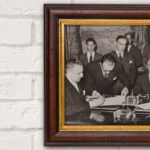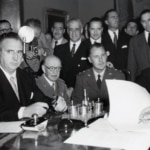Brief history of BBVA (XIX): Economic Opening and the Stabilization Plan
The Spanish economy was at a delicate point at the end of the 1950s. Following the civil war, Franco’s dictatorship managed to revive the economy through major intervention and the imposition of a strong autarchy that isolated Spain commercially from the western countries. The economy grew through these severe measures but indicators such as inflation began to be a concern. The time had come to change the rules of the game, at least in part.

First steps in the opening
The rise of the Cold War between the two new antagonistic blocs after the Second World War favored the interests of Franco's Spain, given his well-known position regarding communism. The United States, led by President Harry S. Truman, refused to condemn the Spanish regime in the United Nations in 1947 or to impose additional sanctions. In 1948, Spain signed their first financial and commercial agreements with France and Great Britain. One year later, the U.S. government approved the first loan from a U.S. bank to Spain, for $25 million.
In November 1950, the UN General Assembly revoked the 1946 resolution condemning Franco’s regime. From that point on, western ambassadors returned to Spain. With the Cold War underway, the United States saw a high geostrategic value in Spain and did not take long to show its appreciation for our country. The scenario that arose as a result of the new U.S: position led its allies to reconsider Spain, in diplomatic and commercial terms.
The Pact of Madrid
Spain and the United States negotiated for months to reach a series of commercial and military agreements that were signed on September 23, 1953 in Madrid. Even though the Franco regime tried to ensure that they were considered “treaties,” they were eventually called pacts because the U.S. Senate – against the Spanish dictatorship – would not have voted in favor of entering into any treaties with Spain.

Signing of the Pact of Madrid in 1953.
What would go down in history as the Pact of Madrid included three agreements. One would supply more than $450 million of U.S. war materials to Spain; another consisted of economic assistance, based on successive loans worth $1.5 billion; the third, a military agreement, covered supplies for U.S. military bases in Spain (Torrejón de Ardoz, Rota, Morón and Zaragoza).
The Pact of Madrid represented the greatest symbol of the end of the Spanish dictatorship’s isolation over the previous decade and a half.
New economic life
If the end of international isolation was brewing in the late 1940s and early 1950s, it would take until the end of the decade to end the autarchy that Franco had self-imposed – twenty years after this constrictive view of the economy had been decreed.
In the mid-1950s, Spain was in a complicated economic situation, as the state-dictated policy started to show signs of fatigue. In 1956, inflation had skyrocketed to an alarming 15%, which led to considerable salary increases. This only exacerbated the situation. On the other hand, the public debt had risen dramatically and the balance of payments showed a very high trade deficit, which reduced Spain’s currency reserves to an alarmingly low level.

Navarro Rubio. Ullastres Calvo and López Rodó.
As a result of all this, the government put its confidence in three economists whose strong background and liberal views started work of putting an end to autarchy. Mariano Navarro Rubio, Alberto Ullastres Calvo and Laureano López Rodó did not take long to put a series of measures into effect:
- The different exchange rates were unified and the exchange rate was set at one dollar to 42 pesetas.
- The Bank of Spain raised interest rates and limits were set for banks’ rediscounts in the Bank of Spain.
- Spain joined the International Monetary Fund, the European Organization for Economic Cooperation and the International Bank for Reconstruction and Development.
- Steps were taken to control and reduce public expenditure.
These measures had a positive impact, but it soon became clear that they were insufficient. More ambitious, liberal measures were needed.
The Stabilization Plan
Spain received technical assistance primarily from the United States, but also from other countries, to devise a plan to liberalize the economic autarchy, escape international suffocation and avoid bankruptcy, which seemed to be right around the corner. The economists Fuentes Quintana and Juan Sardá Dexeus were named by the government to carry the weight of designing what we now know as the Stabilization Plan of 1959.

Fuentes Quintana and Sardá Dexeus.
The Plan was approved in July 1959 by means of a Decree-Law, after significant resistance from the government and Franco himself, who felt that autarchy was a fundamental value in Spain’s ideology.
The Stabilization Plan’s most important goals were economic stability, a sustainable balance of payments and a stronger peseta. Therefore, the following main steps were taken:
- The convertibility of the peseta and setting a new exchange rate of one dollar to 60 pesetas;
- Lowering public expenditure;
- Freezing salaries;
- Raising interest rates;
- Limiting bank loans;
- Promoting foreign investment by changing legislation so that foreign capital could invest in Spanish companies; and
- Fiscal reform, to attempt to lower the public sector deficit by increasing income.
The Stabilization Plan soon began to bear fruit. The Bank of Spain saw its currency reserves increase, the balance of payments had a considerable surplus, foreign investment increased, international tourism started to be a factor to take into account and inflation fell dramatically.
Nevertheless, the change in economic conditions and the increase in exports meant the Stabilization Plan also had negative consequences in the short-term. The lull in national production and salary freezes made conditions worse for workers, and unemployment at first skyrocketed. This forced many Spaniards to move to Europe to search of a more prosperous future.